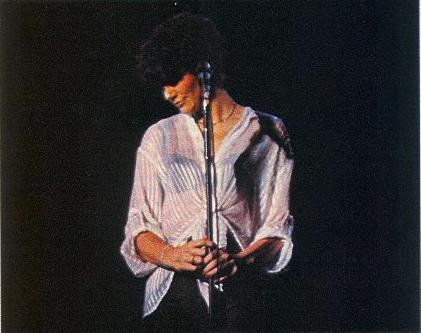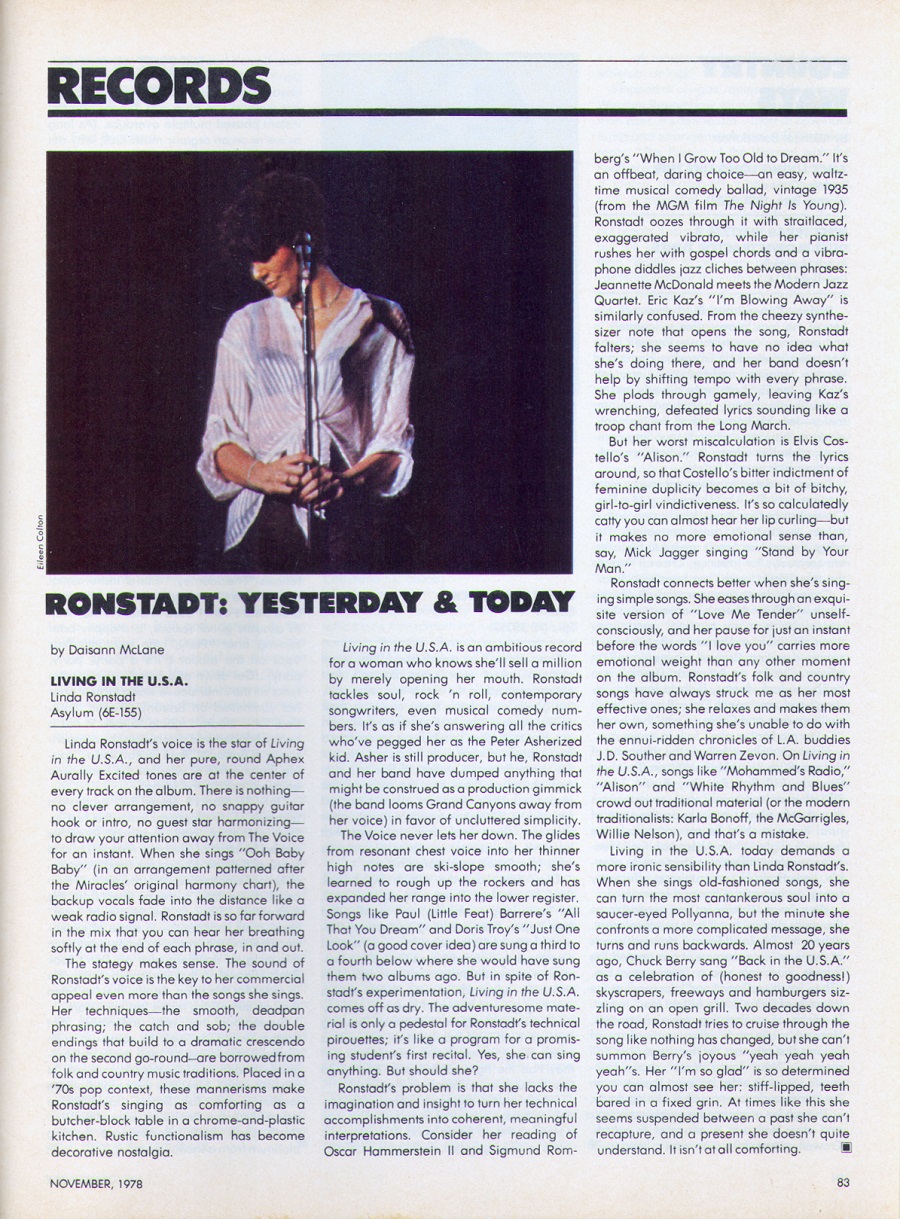Living in the U.S.A.
Crawdaddy / Feature - November 1978



by Daisann McLane
LIVING IN THE U.S.A.
Linda Ronstadt Asylum (6E-155)
_______________________________________
The strategy makes sense. The sound of Ronstadt's voice is the key to her commercial appeal even more than the songs she sings. Her techniques - the smooth, deadpan phrasing; the catch and sob; the double endings that build to a dramatic crescendo on the second go-round - are borrowed from folk and country music traditions. Placed in a '70s pop context, these mannerisms make Ronstadt's singing as comforting as a butcher-block table in a chrome-and-plastic kitchen. Rustic functionalism has become decorative nostalgia.
Living in the U.S.A. is an ambitious record for a woman who knows she'll sell a million by merely opening her mouth. Ronstadt tackles soul, rock 'n roll, contemporary songwriters, even musical comedy numbers. It's as if she's answering all the critics who've pegged her as the Peter Asherized kid. Asher is still producer, but he, Ronstadt and her band have dumped anything that might be construed as a production gimmick (the band looms Grand Canyons away from her voice) in favor of uncluttered simplicity.
The Voice never lets her down. The glides from resonant chest voice into her thinner high notes are ski-slope smooth; she's learned to rough up the rockers and has expanded her range into the lower register. Songs like Paul (Little Feat) Barrere's "AII That You Dream" and Doris Troy's" Just One Look" (a good cover idea) are sung a third to a fourth below where she would have sung them two albums ago. But in spite of Ronstadt's experimentation, Living in the U.S.A. comes off as dry. The adventuresome material is only a pedestal for Ronstadt's technical pirouettes; it's like a program for a promising student's first recital. Yes, she can sing anything. But should she?
Ronstadt's problem is that she lacks the imagination and insight to turn her technical accomplishments into coherent, meaningful interpretations. Consider her reading of Oscar Hammerstein II and Sigmund Romberg's "When I Grow Too Old to Dream." It's an offbeat, daring choice -- an easy, waltz-time musical comedy ballad, vintage 1935 (from the MGM film The Night Is Young). Ronstadt oozes through it with straitlaced, exaggerated vibrato, while her pianist rushes her with gospel chords and a vibraphone diddles jazz cliches between phrases: Jeannette McDonald meets the Modern Jazz Quartet. Eric Kaz's "I'm Blowing Away" is similarly confused. From the cheezy synthesizer note that opens the song, Ronstadt falters; she seems to have no idea what she's doing there, and her band doesn't help by shifting tempo with every phrase. She plods through gamely, leaving Kaz's wrenching, defeated lyrics sounding like a troop chant from the Long March.
But her worst miscalculation is Elvis Costello's "Alison." Ronstadt turns the lyrics around, so that Costello's bitter indictment of feminine duplicity becomes a bit of bitchy, girl-to-girl vindictiveness. It's so calculatedly catty you can almost hear her lip curling - but it makes no more emotional sense than, say, Mick Jagger singing "Stand by Your Man."
Ronstadt connects better when she's singing simple songs. She eases through an exquisite version of "Love Me Tender" unselfconsciously, and her pause for just an instant before the words "I love you" carries more emotional weight than any other moment on the album. Ronstadt's folk and country songs have always struck me as her most effective ones; she relaxes and makes them her own, something she's unable to do with the ennui-ridden chronicles of L.A. buddies J. D. Souther and Warren Zevon. On Living in the U.S.A., songs like "Mohammed's Radio," "Alison" and "White Rhythm and Blues" crowd out traditional material (or the modern traditionalists: Karla Bonoff, the McGarrigles, Willie Nelson), and that's a mistake.
Living in the U.S.A. today demands a more ironic sensibility than Linda Ronstadt's. When she sings old-fashioned songs, she can turn the most cantankerous soul into a saucer-eyed Pollyanna, but the minute she confronts a more complicated message, she turns and runs backwards. Almost 20 years ago, Chuck Berry sang "Back in the U.S.A." as a celebration of (honest to goodness!) skyscrapers, freeways and hamburgers sizzling on an open grill. Two decades down the road, Ronstadt tries to cruise through the song like nothing has changed, but she can't summon Berry's joyous "yeah yeah yeah yeah"s. Her "I'm so glad" is so determined you can almost see her: stiff-lipped, teeth bared in a fixed grin. At times like this she seems suspended between a past she can't recapture, and a present she doesn't quite understand. It isn't at all comforting.
read the CIRCUS Magazine review
